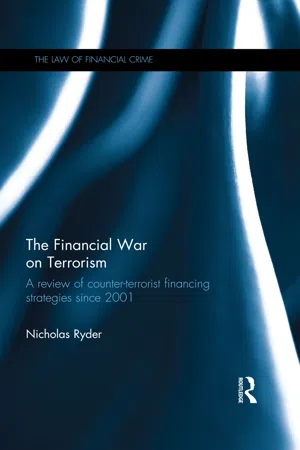
The Financial War on Terrorism
A Review of Counter-Terrorist Financing Strategies Since 2001
- 210 pages
- English
- ePUB (mobile friendly)
- Available on iOS & Android
The Financial War on Terrorism
A Review of Counter-Terrorist Financing Strategies Since 2001
About This Book
On September 11, 2001, 19 terrorists committed the largest and deadliest terrorist attack in the United States of America. The response from the inter-national community, and in particular the US, was swift. President George Bush declared what has commonly been referred to as either the 'War on Terror' or the 'Global War on Terror' on September 20, 2001. Four days later, he instigated the 'Financial War on Terrorism'. This book defines and identifies the so-called 'Financial War on Terrorism'. It provides a critical review of the impact of counter-terrorist financing strategies enacted by both individual jurisdictions and international organisations.
Taking a comparative approach, the book highlights the levels of compliance in each selected jurisdiction and organisation with the requirements of the 'Financial War on Terrorism'. The book analyses measures introduced by the United Nations, including the UN sanctions against terrorists and the operation of its anti-terrorist sanctions committees, and the Recommendations of the Financial Action Task Force. It also reviews the counter-terrorist financing measures of the European Union and the Council of Europe, paying particular attention to the Framework Decisions on Combating Terrorism, the Council Common Positions on Combating Terrorism and the EU Anti-Terrorism Sanctions Regime. The book goes on to review the measures put in place in the US following September 11, 2001.
Offering a much-needed legal analysis of the measures enacted under the 'Financial War on Terrorism', this book is a valuable resource for those researching in law, terrorism studies, criminal justice, and finance.
Frequently asked questions
1 Introduction
1.1 September 11, 2001 and the War on Terrorism
1.2 The Financial War on Terrorism and terrorist financing
Decades of work on money laundering was silenced by the assault on New York and Washington. It seemed as if the world had been observed through the wrong end of a telescope. Money had been spirited around the globe, by means and measures and in denominations that mocked detection. The more immediate threat to well-being was ‘clean’ money intended to kill, not illicit proceeds of crime looking for a place to hide. 2121 Aufhauser, D. ‘Terrorist financin...
Table of contents
- Cover Page
- Half-Title Page
- Title Page
- Copyright Page
- Table of Contents
- Acknowledgements
- Preface
- 1 Introduction
- 2 International counter-terrorist financing measures and the ‘Financial War on Terrorism’
- 3 The United States of America
- 4 The United Kingdom
- 5 Australia
- 6 Terrorist financing – current threats and future trends
- 7 Conclusions and recommendations
- Bibliography
- Index